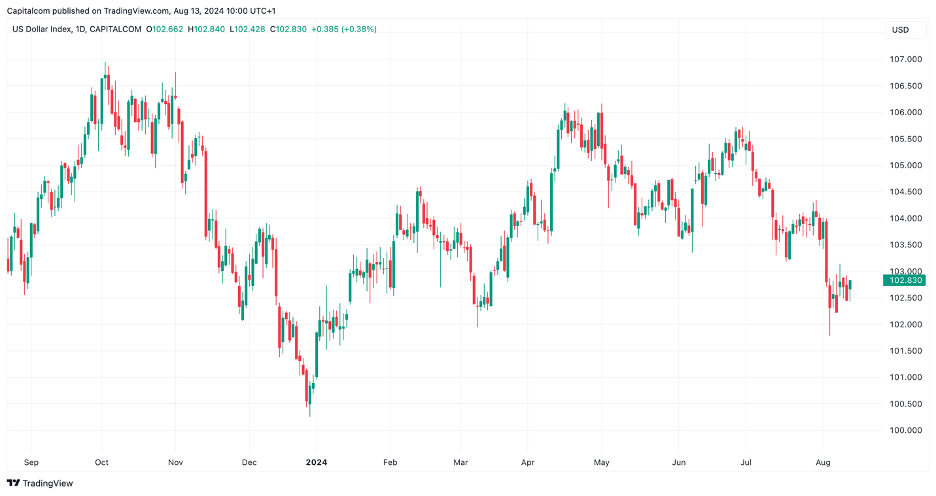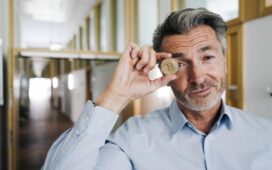Just over a month has gone by since the latest was released in the US and so much has happened since. Markets endured what is possibly the biggest scare since the pandemic, but the economic landscape remains uncertain, and the fed funds rate has yet to come down. Therefore, this week is going to be important.
The June CPI reading saw inflation in the US drop unexpectedly to 3% from 3.3% in May. Markets had been expecting the figure to come in at 3.1%. But what caught investors more by surprise was that fact that, on a monthly basis, consumer prices had dropped for the first time in four years, giving a sense of victory over the battle against inflation. That said, core inflation, which exclude volatile prices like food and energy, remained mostly unchanged, but the momentum was still set on the start of a deeper correction.
The combination of softer inflation and a cooling labour market triggered the selloff frenzy seen in markets last week, aided by an unchanged verdict from the Federal Reserve and a rate hike from the Bank of Japan. This led to a call for an immediate out-of-cycle cut from the US central bank, which as expected was not delivered as it only would have served to cause more panic in markets. The next best option was a call for a 50-basis point cut (bypassing the expected 25bps) at the Fed’s next meeting on September 18th, but even that has started to lose strength. At the end of the day, as pointed out by several FOMC members, the US economy is not showing severe signs of a recession just yet, even if inflation and the labour market are cooling. In fact, just a few months ago markets were begging to see the data move in the way it has.
So, what can we expect from the upcoming US CPI data? Volatility, for one. Markets are now geared up to focus on specific data points and read between the lines. The rhetoric can go in either of two ways: the data comes in softer than expected and reaffirms the fact that the Fed made the wrong decision in June and now the economy is showing clear signs of slowing and therefore a is the only way to go. If so, we could see recession concerns reignited, weighing on the dollar and yields. The impact on the stock market could be a little more diverse, with those stocks sensitive to the economic cycle seeing some downside pressure, whilst other more resilient sectors could find support in the expectation of lower rates.
The other option is a stronger-than-expected reading, which would undo a lot of the thought process that has happened over the past two weeks. This would likely see the call for 100bps of cuts in the remainder of 2024 lose some strength, reaffirming the Fed’s decision to keep rates unchanged, with pricing leaning more towards a 25bps cut in September. In this case, we could see the US dollar strengthen and equities struggling to find bullish support, whilst gold could benefit from increased concerns about the impact of elevated rates on economic growth.
(DXY) daily chart
Past performance is not a reliable indicator of future results.
Across the Atlantic, the will also be released on Wednesday. Analysts are anticipating a rise to 2.3% in July up reading. Meanwhile, is expected to have eased further to 3.4%, which would be the lowest reading since October 2021. Unlike the Fed, the Bank of England did decide to cut rates at their last meeting, following in the ECB’s steps.
The central bank also released updated economic projections at the meeting earlier this month, which showed inflation expected to remain above the 2% target this year, before dropping back down in 2025 as restrictive policy weighs on growth. Thus, a rise in CPI should not take markets by surprise, even if the bank has started to cut rates already. In its statement it made it clear that policy will need to remain restrictive for sufficiently longer, suggesting that a strict cutting cycle will not take place just yet. Market pricing shows a 66% chance that the BoE keeps at its next meeting on September 19th.
The jobs report released this morning has likely influenced the latest pricing as it showcased a resilient labour market. The latest numbers show the unemployment rate is down by 0.2% to 4.2%, against expectations of a rise. Given that the data is based on three-month moving averages, the reading is quite striking as it tends to be less volatile. Meanwhile, average earnings came in higher-than-expected a continued worry of the BoE’s hawks as wage growth continues to be stickier than expected.
Because of this, it is safe to assume that the bank will hold back on cutting rates at its next meeting, focusing on November as the likely candidate for another round of easing. Markets are currently pricing in 25 bps of cuts by then, supporting this view.
The British pound has been picking up some support this morning after the data release, with back above 1.28 and undoing some of the recent weakness. The anticipation of both UK and US CPI on Wednesday could play in GBP/USD’s favour as investors seem cautious about buying USD ahead of the data release in case it triggers another selloff.
GBP/USD daily chart

Disclaimer: This is for information and learning purposes only. The information provided does not constitute investment advice nor take into account the individual financial circumstances or objectives of any investor. Any information that may be provided relating to past performance is not a reliable indicator of future results or performance. Social media channels are not relevant for UK residents.
Spread bets and CFDs are complex instruments and come with a high risk of losing money rapidly due to leverage. 84.01% of retail investor accounts lose money when trading spread bets and CFDs with this provider. You should consider whether you understand how spread bets and CFDs work and whether you can afford to take the high risk of losing your money.
The information provided is not to be considered investment advice or investment research. Capital.com will not be liable for any losses from the use of the information provided.’





